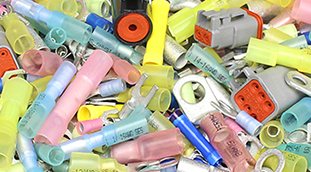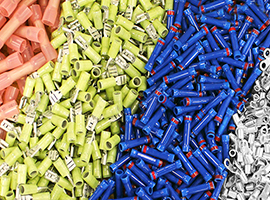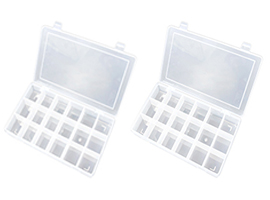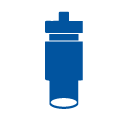Categories
- Wire & Cable
- Multi-conductor & Signal Cable
- Battery Cable Assemblies
- Terminals and Connectors
- Electrical Parts
- Electrical Tools
- ID Products
- Wire Management
- Tape & Sealant
- Mounting Panels & Panel Blanks

Need Help?
Click HereGet a Business Account
Apply HereTerminals and Connectors



What do we mean by terminals and connectors?
Terminals and connectors are various types of electrical wire components used to connect a wire or cable to an electrical system or terminate the end. They can be anything from ring terminals, butt splices, wire caps, wire ferrules, fork terminals, pin terminals, or a host of other styles. Pacer carries many terminals and connectors, from waterproof connectors to battery posts and everything in between. When selecting wire terminals, consider the application requirements. Do you need waterproof terminals? Is vibration resistance important? What kind of temperatures will the wire terminals need to handle? Questions like these will help you filter the type and style of wire terminal or connector that will work best for your application.
"Pacer carries everything from waterproof connectors to battery posts and everything between."

Deutsch Connectors

Delphi Connectors

Butt Splices

Ring Terminals

Fork Terminals

Disconnects

Lugs & Splices

Coax Connectors

Terminal Kits

Compression Seal Connectors

Battery Posts & Boots

Terminal Boxes

Wire Joints

Wire Ferrules
Where are these products implemented?

Terminals and connectors are available in multiple styles
Terminals and connectors are implemented to connect wires and cables to pieces of equipment in an electrical system. They can be used for new installations or when replacing older connectors. If you have bent connectors, cracked terminals, burnt or cracked connectors, or terminals with any damage, then it's time to replace them. Not only will you find the terminals and connectors you need at Pacer, but you will also find we carry all the proper tools needed to install any of these products. Most electrical wire applications call for at least some wire crimpers. We offer the best types of crimp connectors out there. OEMs turn to us for our wire connectors and tools. Now that we've covered the basics, let's look at what types are available.
What types do we offer?
We understand that no two jobs are alike, and as such, a variety of parts and tools are needed to give the best possible solutions. That is why Pacer carries a range of wire terminals and connectors. Each type of terminal or connector we carry is something we feel people need access to. By carrying more than the average retailer, we are offering the greatest number of solutions and ensuring that you find what you need. Let’s look below at some of the more popular styles we carry.
Environmentally sealed connectors
These connectors are designed for use where cable-to-cable circuits need to handle harsh conditions. One major advantage of environmentally sealed connectors is that they are field serviceable. No need to cut, strip, and re-terminate wires to repair a connection. With these electrical connector types, you simply disengage the locking mechanism, pull them apart, make your changes, and reconnect them. It really is that simple. This is one of many reasons you’ll find these in a multitude of industrial applications.
| Series of Connector | Type of Terminal | Wire Gauge |
|---|---|---|
| DTM (mini) | Sealed Connector | Twenty-Four Gauge - Twenty Gauge (24AWG - 20AWG) |
| DT (standard) | Sealed Connector | Twenty-Gauge - Fourteen Gauge (20AWG - 14AWG) |
| DTP (power) | Sealed Connector | Fourteen Gauge - Ten Gauge (14AWG - 10AWG) |
| DTHD (heavy duty) | Sealed Connector | Ten Gauge - Six Gauge (10AWG - 6AWG) |
Butt splices
This type of connector is used to safely connect one or more wires to another wire or set of wires. There are a variety of styles depending on what the task at hand is. If you simply need to replace a section of wire, a regular butt splice will work. In some cases, you may need to connect two smaller gauge wires to a larger one. In that situation, you would want to use step-down butt splices. Utilizing butt splices reduces the number of wire connectors to crimp. Remember, pay attention to the conditions your connection will need to endure and use that to help select the right type of insulation for your project.
| Type of Splice | Type of Terminal | Wire Gauge |
|---|---|---|
| Heat Shrink | Butt splice | Twenty-Two Gauge - Eight Gauge (22AWG - 8AWG) |
| Step-Down Heat Shrink | Butt splice | Twenty-Two Gauge - Ten Gauge (22AWG - 10AWG) |
| Step-Down Tinned Splice | Butt splice | Twenty-Two Gauge - Six Gauge (22AWG - 6AWG) |
| Nylon Splice | Butt splice | Eight Gauge - Six Gauge (8AWG - 4AWG) |
| Seamless Barrel Splice | Butt splice | Twenty-Two Gauge - Ten Gauge (22AWG - 10AWG) |
| Seamless Tinned Splice | Butt splice | Eight Gauge - Four Aught (8AWG - 4/0AWG) |
Ring Terminals
These connectors are the most secure type of tongue-style wire terminals. They fit cleanly over a stud and are held in place by the locking nut. The advantage of ring terminals is that they remove the possibility of terminal slippage you may find with other types of terminals. These are a common choice due to their durability and ease of installation. They are easy wire connectors to crimp. Depending on the application, you can connect multiple wires to a single ring terminal or connect multiple ring terminals to a single stud.
| Insulation Styles | Type of Terminal | Wire Gauge |
|---|---|---|
| Non-Insulated | Ring Terminal | Twenty-Two Gauge - Ten Gauge (22AWG - 10AWG) |
| Nylon | Ring Terminal | Twenty-Two Gauge - Ten Gauge (22AWG - 10AWG) |
| Vinyl | Ring Terminal | Twenty-Two Gauge - Ten Gauge (22AWG - 10AWG) |
| Heat Shrink | Ring Terminal | Twenty-Two Gauge - Ten Gauge (22AWG - 10AWG) |
Fork Terminals
We carry these types of wire terminals in two options, locking and flanged. Fork terminals are a useful type of electrical wire connector in environments where you may need to make adjustments without having to fully remove a screw. When using fork terminals to connect one or more wires to a stud, you want to be confident that it will not come loose. Commonly in an electrical environment, vibration can loosen holding screws. To combat this, we recommend both flanged forks, which snap around the stud creating a solid connection, or locking forks, which grip the nut, also creating a solid connection. This way you know that you've created a solid connection that will not come loose.
| Insulation Styles | Type of Terminal | Wire Gauge |
|---|---|---|
| Non-Insulated | Fork Terminal | Twenty-Two Gauge - Ten Gauge (22AWG - 10AWG) |
| Nylon | Fork Terminal | Twenty-Two Gauge - Ten Gauge (22AWG - 10AWG) |
| Vinyl | Fork Terminal | Twenty-Two Gauge - Ten Gauge (22AWG - 10AWG) |
| Heat Shrink | Fork Terminal | Twenty-Two Gauge - Ten Gauge (22AWG - 10AWG) |
Disconnects
These wire terminals are designed for use where the electrical connection is intended to be connected and disconnected multiple times. This is why disconnects are a preferred choice when it comes to field serviceability. They offer superior holding force due to the indentation of the tab of the female part locking into the hole in the male part. This type of connector is known for being a simple wire connector to crimp. Their ease of use makes them a solid choice. Even though they are built for disconnection and reconnection, they are equally built for permanent placement. If you plan to leave them as a permanent option, choose the insulation type that best supports the environment where you will be placing them.
| Insulation Styles or Type of Connector | Type of Terminal | Wire Gauge |
|---|---|---|
| Heat Shrink Fully Insulated | Disconnect | Eighteen Gauge - Ten Gauge (18AWG - 10AWG) |
| Heat Shrink Partially Insulated | Disconnect | Eighteen Gauge - Ten Gauge (18AWG - 10AWG) |
| Nylon Fully Insulated | Disconnect | Twenty-Two Gauge - Ten Gauge (22AWG - 10AWG) |
| Nylon Partially Insulated | Disconnect | Twenty-Two Gauge - Ten Gauge (22AWG - 10AWG) |
| Non-Insulated | Disconnect | Twenty-Two Gauge - Ten Gauge (22AWG - 10AWG) |
| Bullet Connectors | Bullet Disconnect | Twenty-Two Gauge - Fourteen Gauge (22AWG - 14AWG) |
| Piggyback Connectors | Piggyback Disconnect | Sixteen Gauge - Ten Gauge (16AWG - 10AWG) |
Pin Terminals
Pin terminals are commonly found in use with compression-type terminal blocks. Many terminal blocks use a screw to hold a wire in place. The issue is that many people must deal with an electrical system that uses stranded wire, not solid. When you tighten a screw down on a collection of smaller conductors, the individual wires become frayed or weakened. This can lead to long-term issues, including a loss of connection. The solution is to use a pin terminal to consolidate the stranded wires into a solid wire. These are an effective choice when it comes to electrical wire connectors. Now once the screw tightens, the force is applied equally, and damage is avoided.
| Insulation Styles | Type of Connector | Wire Gauge |
|---|---|---|
| Vinyl | Pin Terminal | Twenty-Two Gauge - Ten Gauge (22AWG - 10AWG) |
Lugs
Closed-end lugs are like ring terminals in the way they connect the wire to the electrical system. However, lugs are much more durable and are usually meant for either larger gauge wire and cable or for harsh environments where corrosion is an increased risk. These are high-quality, durable electrical wire connectors. Think about it; you wouldn’t use a ring terminal to connect a car battery. You would use something specifically meant to handle a tough environment. When considering wire connectors to crimp, factor in the level of protection needed. To be as effective as possible, lugs are designed to be tough and highly conductive. That’s why all the lugs we carry are made from high-quality copper for the highest level of conductivity.
| Wire Gauge | Type of Terminal | Stud Sizes |
|---|---|---|
| Eight Gauge - Four Aught (8AWG - 4/0AWG) | Lug | #10, 1/4", 5/16", 3/8", 1/2" |
Coaxial Connectors
These connectors vary in their design much more than most other types of wire terminals. They are available in everything from snap-in connectors to twist-on electrical wire connectors and even some that require soldering. This is due to coaxial connectors being used in a wide range of applications and industries. For this reason, they need to be versatile to meet a range of needs. They are used in everything from radio transmissions and digital broadcasting to microwave industries. These are specialized wire connectors to crimp and may require specialized tools. Before selecting the connector, be aware of the specific usage and the type of mating the connector will need to offer.
| Series of Connector | Type of Terminal | Cable Type |
|---|---|---|
| BNC Series | Coaxial Connector | RG58, RG59, RG62 |
| PL259 Reducer Connectors | Coaxial Connector | RG58, RG59, RG62, RG8X, LMR-240 |
Compression Seal Connectors
These connectors are used to create a permanent seal. That means that they must be built with durability and longevity in mind. Compression seal connectors are used with coaxial cables, but their installation process is vastly different. Compression tools are used on these wire connectors to crimp them correctly which guarantees the permanent seal mentioned above. This keeps the electrical wire connectors from ever coming off or being pulled out. All Pacer compression seal connectors are made from machined annealed brass and coated with an anti-corrosion nickel plated finish.
| Series of Connector | Type of Terminal | Cable Type |
|---|---|---|
| BNC Series | Compressional Seal Connector | RG6, RG59, LMR-240 |
| Female Seal Connector | Compressional Seal Connector | RG6, RG59, LMR-240 |
Battery Posts
This type of electrical cable connectors are used to connect a load to a battery. To give the highest level of conductivity, all Pacer battery posts are made from 131 contact copper. We use this type of copper as it is 95% pure, making it highly conductive. Specialized tools may be needed to work with these wire connectors to crimp them correctly. To prevent corrosion from affecting the post, each one is electro-plated with a bright tin-finish. For an added layer of protection, you can add a boot to cover your post. This will help to extend the life of the connection.
| Style of Post | Type of Terminal | Wire Gauge |
|---|---|---|
| Straight Post | Battery Post | Six Gauge - Four Aught (6AWG - 4/0AWG) |
| Side Post | Battery Post | One Gauge - Four Aught (1AWG - 4/0AWG) |
| Flag Post | Battery Post | One Aught - Four Aught (1/0AWG - 4/0AWG) |
| Marine Type Top Post | Battery Post | N/A |
Wire Ferrules
When you work with terminal blocks, using the non-terminated end of stranded wires as a connection point will lead to fraying and weakening of the connection. You want to consolidate your stranded wires into one singular point of connection. This is where wire ferrules come in. They create a superior connection to a terminal block. By consolidating the wires into the ferrule, you minimize your risks of the connection fraying or coming loose. This, in turn, creates a stronger connection. These are simple wire connectors to crimp once you have the proper tools. Pacer carries the crimp tools needed for all our wire ferrules.
| Connector Color | Type of Terminal | Wire Gauge |
|---|---|---|
| Turquoise | Wire Ferrule | Twenty-Four Gauge - Twenty-Two Gauge (24AWG - 22AWG) |
| Orange | Wire Ferrule | Twenty-Two Gauge - Twenty Gauge (22AWG - 20AWG) |
| White | Wire Ferrule | Twenty Gauge - Eighteen Gauge(20AWG - 18AWG) |
| Yellow | Wire Ferrule | Eighteen Gauge (18AWG) |
| Red | Wire Ferrule | Sixteen Gauge (16AWG) |
| Blue | Wire Ferrule | Fourteen Gauge (14AWG) |
| Grey | Wire Ferrule | Twelve Gauge (12AWG) |
| Black | Wire Ferrule | Ten Gauge (10AWG) |
| Ivory | Wire Ferrule | Eight Gauge (8AWG) |
| Green | Wire Ferrule | Six Gauge (6AWG) |
| Brown | Wire Ferrule | Four Gauge (4AWG) |
| Beige | Wire Ferrule | Two Gauge (2AWG) |
What types of insulation are available?

The insulation found on terminals and connectors determines, in part, the environments they can handle as well as their overall longevity. Pacer carries many wire terminals in four insulation options: heat shrink, nylon, vinyl, and non-insulated.
Heat shrink terminals offer a range of advantages, which is why they are a popular choice. For starters, epoxy-lined heat shrink creates a moisture-proof barrier that will prevent corrosion from damaging your conductors. This is especially important in marine environments. Heat shrink terminals also offer more flexibility and abrasion resistance, meaning that they will last longer than other styles in most conditions. Another benefit of heat shrink terminals is that they are translucent. This means you can easily inspect your crimp to make sure the connection is strong.
Nylon terminals, in many cases, are double crimped. This is where the crimp on the wire is strengthened by a secondary crimp on the insulation. This makes the connection stronger and adds to its overall life. Nylon terminals are semi-translucent, which means that visual inspection of the crimp can verify the connection.
Vinyl terminals are the most cost-effective insulated option. They are available in a wide range of styles and are a very common choice when looking at wire connectors on a budget.
Non-insulated terminals are the least expensive; however, they offer the least amount of protection. One strong point of non-insulated is that the crimp is easy to inspect. In certain circumstances, solder can be added to strengthen the connection and create a better connection and protective seal.
Are specialized tools required to use these terminals & connectors?

When dealing with your electrical wire connectors, the electrical system, or its components, using the correct tools is an absolute must. Without the proper tools, you run the risk of damaging the terminal or the wire itself. Knowing this, Pacer takes steps to carry the tools for all the wire terminals or connectors we offer. This way you’re never left wondering which tool to use for a particular item. Find the tool you’re looking for here. Of course, with such a variety of terminals and connectors, there is going to be a variety of tools to accompany them. We have taken steps to make the selection process as easy as possible so you can get the parts and tools you need. As always, contact a Pacer expert and let us guide you to the proper tools for your applications.
What are terminal boxes used for?

Terminal boxes are used in a variety of ways, such as field service, where a range of terminals is needed on hand. They are also commonly found in work trucks where quick access to terminals speeds up maintenance and installation. This makes them ideal for carrying all the terminals and connectors needed. Terminal boxes have multiple compartments for various terminals so you can have forks, rings, splices, pins, and more, all easily separated and organized.
What compliance's do these terminals & connectors meet?
Pacer strives to offer the greatest number of solutions possible. To offer the best solutions, they must be backed up with evidence. That is why we put so much effort into carrying products that meet or exceed industry compliances. You will find product specific compliances on respective product pages as well as overall compliances for a product family on the respective category page. Understand that compliances and standards can vary greatly from one type of terminal to another, even in the same group. All the electrical wire connectors we carry are built to last. We are confident in our products and stand behind the compliances they carry. Contact a Pacer expert with any specific questions you have about the compliances and standards our parts meet.
*This page was updated on 2/04/2025*

























